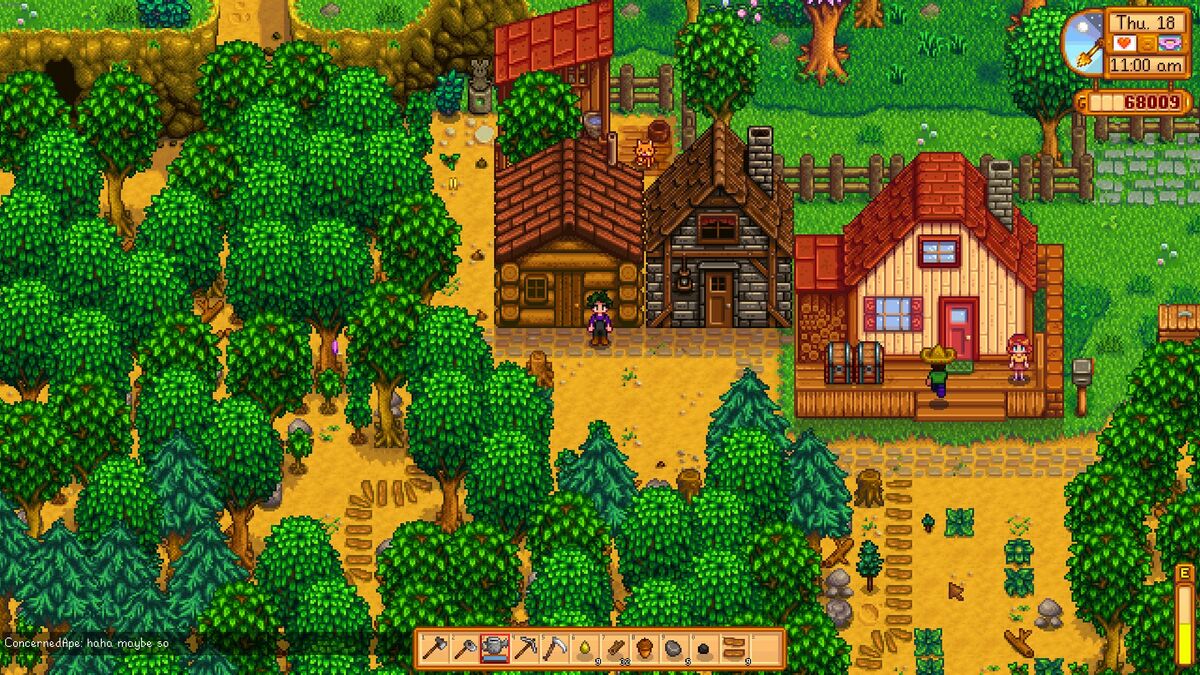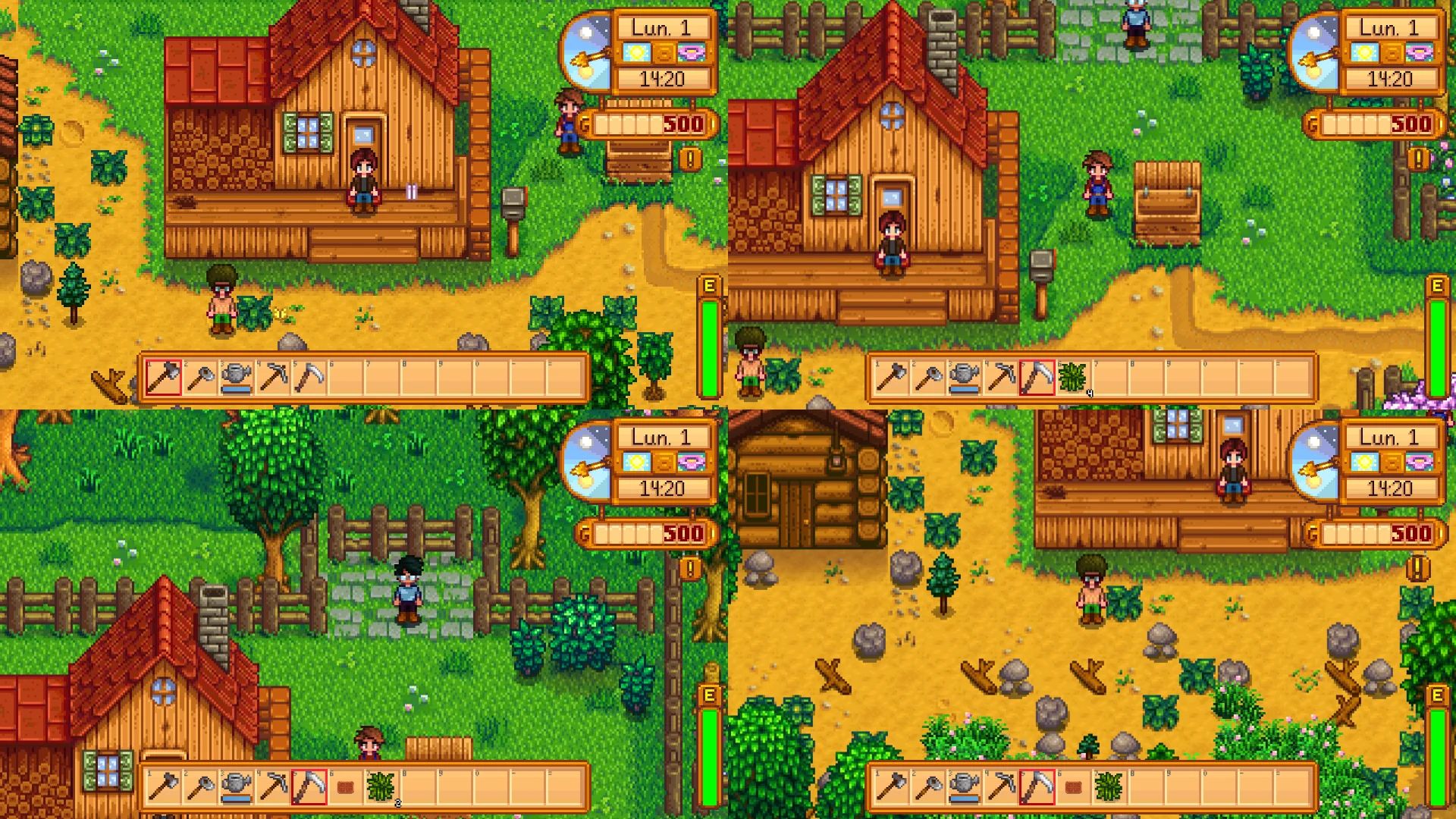Co-op Basics
After you purchase a “co-op” from Robin the Carpenter, you will be required to choose where to place it on your property. You will need to consider the needs of the “co-op” and any future buildings you may want to add to your property. The first “co-op” is quite small and only needs a 6×3 space. However, future “co-op” upgrades require more space. You may also want to consider building your “co-op” near a water source so you can place a trough. The “co-op” has two levels. The first thing to know is that you don’t need to build a ladder for the Animals to get into their “co-op.” In the morning the “co-op” door will automatically open and the animals will leave the “co-op.” At night, the door will automatically close. However, there may be some instances when the animals will not return to the “co-op” because they are in the way of the door. If you have a Deluxe “co-op,” the door to the outside runs through the middle of the building, and the floor counts as two separate floors. So if your “co-op” is full and you try to open the second-level “co-op” door, you may find that it is in the way of an Animal and you will be unable to open it. By upgrading the “co-op” itself (by purchasing the Big “co-op” from Robin’s shop for 10,000 gold and 400 Wood), you will be able to leave the Animals inside their “co-op” indefinitely. However, keep in mind that wild animals, such as the Cat, Linus or Birds, may appear inside your “co-op” during the night and the Animals will not produce any Animal Products during that day.
Building a Co-op

Once you reach your first year in Stardew Valley, you’ll be given the option to build a co-op for yourself. In this co-op, you’ll be able to rear chickens and ducks, and even manage the eggs that they lay. In this guide, we’ll take you through everything you need to know about the Stardew Valley co-op. You’ll learn about its construction and management, and even what to do with the produce your animals give you. The first thing you need to know about a Stardew Valley co-op is that you can’t just jump in and start building it. First, you’ll need to save up to 4000 gold and have the basics of a farm underway. If you haven’t already worked through this stage, it’s time to get to know a bit more about the Valley. Once you have the capital and you are well-versed in your potential location for the co-op, you’re ready to start building. First, you’ll need to go to Robin’s carpenter shop. This is located in the town and is usually open from 9 am to 5 pm. Robin’s shop is open every day except Friday and will be closed on festival days. When you enter the shop, straight away you’ll be greeted with the option to build a co-op. Robin’s offer is comprehensive and gives you four choices. However, the common-or-garden Stardew Valley co-op is the cheapest and it’s the best for beginners. If you feel like becoming a duck tycoon, you can go for the more expensive options of Big Coop, Deluxe Co-op and the ridiculously extravagant Shed. But a starting co-op will suffice for now. When it comes to building the actual co-op itself, the guide is good; first, it just tells you that you need 300 wood and 100 stone. Then it helpfully tells you that if you need more supplies, wood can be acquired by cutting down trees, and stone can be acquired by breaking rocks. Also, you can find what you need to build the structure near the carpenter’s shop. And that’s about it; no matter how many times you blast the guide with your enchanted Stardew Valley and rock the little creature, it just won’t give you any more information. Such a shame!
Co-op Upgrades

The first co-op upgrade you can make is to add an “Auto Feeder”. The Autofeeder gives you the ability to load up the feeding area with enough feed for the full seven-day in-game week period – a great time-saving invention. The second and final co-op upgrade you can purchase is the “Deluxe co-op”. This amazing creation not only looks fantastic but upgrades your co-op to have the capacity to raise rabbits, ducks, and dinosaurs! For the budding palaeontologists among you, this is the only way to obtain dinosaur eggs and subsequently, dinosaurs themselves! The Deluxe co-op has an integrated incubator which allows you to incubate and hatch all types of eggs without having to use your valuable co-op space. Also, chickens and ducks will create the essential “Duck Feathers”. These are some of the ingredients needed to make the “Deluxe Speed-Gro” fertilizer, which will help you grow the best quality crops in the game.
Managing Animals

Alright, so first things first – pick an animal from the menu on the left. Once you’ve got that sorted, feel free to give them a new name by clicking on the text box below their picture. Make sure to check the box so your animals head indoors at night, especially if you have pets. Your furry friends can hang out outside while your farm animals chill inside, safe and sound. Pets will automatically head inside when you log off the game in the morning.
If your farm already has animals or if you’ve got a new pet, look for the “Pet Adoption Line” option. You can set your default pet in the customization feature under “Overview”. Choose between having a default pet or adopting a dog or cat.
If you’re ready to start adding more animals to your farm, check out the “Purchase Animals” option. You can snag yourself some chickens, cows, sheep, and pigs. The first animal you get opens up the barn door. If you’re looking to expand, you can also build new livestock buildings like a co-op for winged creatures or a barn for larger animals.
Feeling like rearranging things a bit? Once you’ve got your animals, you can move them around with the “Rearrange” option. Just click and drag their picture to wherever you want them. Keeping animals happy means feeding them – whether it’s letting them graze on grass or putting out some hay for them inside. Remember, happy animals produce better-quality products.
As your farm grows, consider labelling your animals based on priority. This will help you quickly identify which ones need attention. Labels can be added or removed by selecting the animal and using the “Info” option. Keep those animals happy and healthy!
